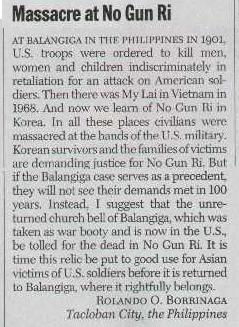
In its October 11, 1999 issue, TIME Magazine carried feature articles about the massacre by U.S. soldiers of civilian men, women, and children in the village of No Gun Ri in Korea sometime in July 1950, around the start of the Korean War. That incident reminded me of a similar act in 1901 by U.S. soldiers on Samar Island in the Philippines, which had been made synonymous with the town of Balangiga, where a company of U.S. troops was earlier massacred by native attackers. The result was the following letter, which I sent by e-mail:
Dear Sirs:
First, it was Balangiga in the Philippines in 1901. Then My Lai in Vietnam in 1968. Then back to No Gun Ri in Korea in 1950. All these places suffered from massacres of civilians at the hands of U.S. soldiers out to protect American interests in the Asian region.
Now Korean survivors and families of victims are demanding justice for the No Gun Ri incident (Asia, Oct. 11). But if the Balangiga incident were to be the basis, they will not get their demands in a century. Instead, in the spirit of ecumenism, I suggest that the unreturned church bell of Balangiga, a treasured war booty of the U.S. Ninth Infantry Regiment now stationed in Korea, be tolled for the dead in No Gun Ri. The place might be within hearing distance of the U.S. military camp where the bell is kept. It is time this relic be put to good use for Asian victims of massacres by U.S. soldiers, before it gets returned to Balangiga where it rightfully belongs.
Very truly yours,
ROLANDO O. BORRINAGA
New York cor. Minnesota Sts.
Phase 4 - Extension
V&G Subdivision
Tacloban City, Leyte
Philippines
6000
(Telephone number)
I was notified that the letter would come out in the November 8, 1999 issue of the magazine. When it finally came out, I almost did not recognize my writing. Worse, the Balangiga bell in Korea was placed in the United States. The published version is shown at the top of this page.